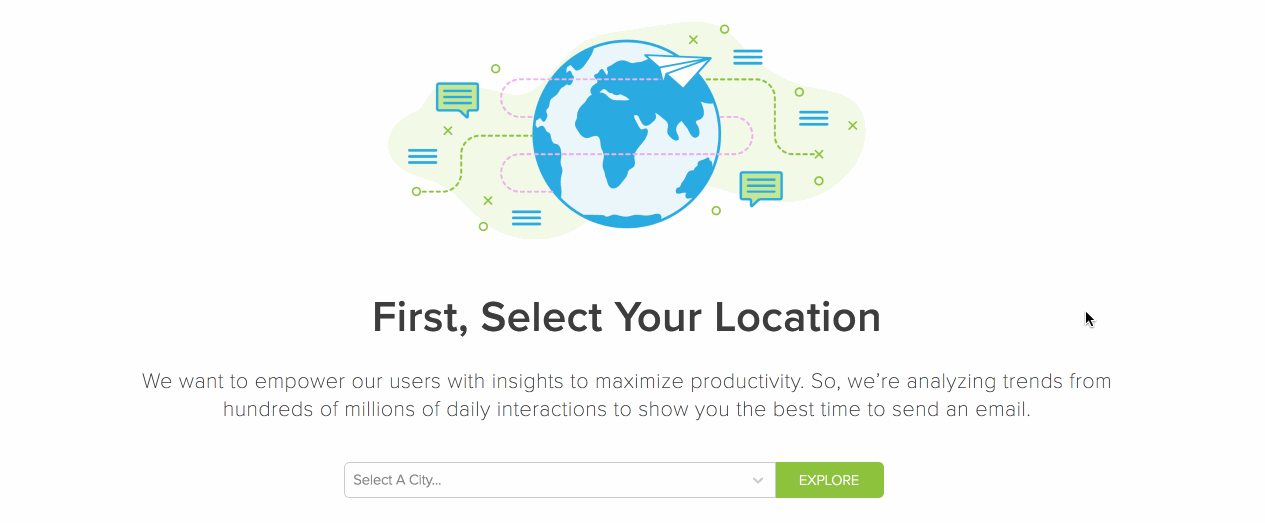Best Time to Send Email: Time, Day, and Frequency [2020 Data]
Jenny Keohane
Contents
- The Best Time to Send Email Based on Reply Rates
- The Best Time of Day to Send Email
- The Best Day of the Week to Send Email
- Email Frequency: Best Time to Send Email Follow-Ups
- Overall Best Time to Send Email Campaigns: Connecting the Dots
- Bonus: Additional Findings — Different Cities Reply to Emails at Different Times
- Free Tool: The Best Time to Send Email Map
- Conclusion
The best time to send email is constantly changing. In 2020, it takes just one day for an email to be a lost cause, which means ensuring your cold emails land in the recipient’s inbox at the right time has never been more important.
In this study, we draw from hundreds of thousands of email activity over the last quarter to dissect the optimal timing for your cold outreach, email campaigns, and follow-ups.
Sneak peek: Based on our data, the best time for sending emails is 1 PM.
We also dissect the best day and frequency to send emails based on reply rates. Then, we break it down a step further and analyze the life span of an email which reveals benchmarks that’ll substantially help shape your follow-up strategy.
Let’s take a look:
- Why Our Study Is Different
- The Best Time of Day to Send Email
- The Best Day of the Week to Send Email
- Best Time to Send Email Follow-Ups
- Connecting the Dots
- Bonus: Additional Findings & Free Tool
The Best Time to Send Email Based on Reply Rates
Why Our Study Is Different
When is the best time to send an email?
There have been countless studies that attempt to answer this question for millions of sales professionals who want to ensure their emails reach recipients’ inboxes at the best possible time.
But the thing is, the majority of these studies only focus on email open rates. These studies may focus on email marketing campaigns or look at the engagement of newsletter subscribers. And although this metric is important for marketers, sales reps care more about replies.
The thing is, an email open doesn’t mean the recipient is necessarily reading your message. You might get the highest open rates for an email campaign and it still not generate the results you’d like. The harsh reality is that sometimes recipients simply open emails to get rid of that annoying red notification.
So, let’s focus on the important metrics and find the perfect time to send an email.
In this study, we look at the best time of day, the best day of the week, and the best follow-up frequency for your emails – all based on reply rates. Let’s jump right in.
The Best Time of Day to Send Email
Based on our data, the best time for sending emails is 1 PM.
And the second best time to send email is 11 AM.
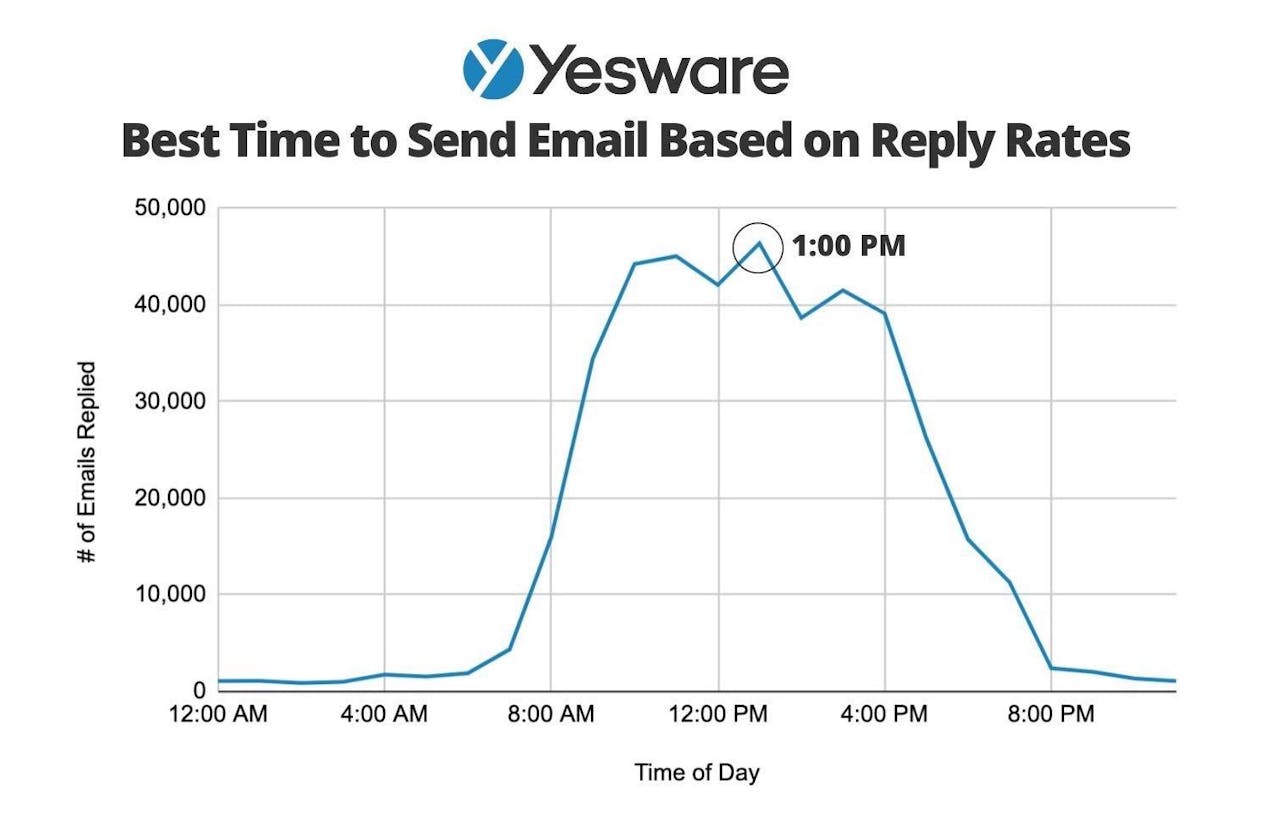
This data tells us that 1 PM receives the highest replies with an average of 46,000 replies. And 11 AM, the second-highest replied time, receives an average of 45,000 replies.
The data also reveals that low reply volume exists between the time of 8 PM-7 AM, which is clear evidence to avoid this time frame.
Notice that there’s a dip around lunchtime, 12-1 PM, and then a sudden incline at 1 PM when returning from lunch. This finding can help you plan your cold outreach either before or at the end of your lunch break, so your emails are at the top of your recipient’s inbox when they get back.
Another notable data point is how significant the drop is after 4 PM. This is evidence that sending an email any later than this time will only decrease the likelihood of getting a response no matter how enticing your subject line is.
Overall, your ideal time blocks for email outreach are 1-3 PM and 9-11 AM.
The Best Day of the Week to Send Email
What is the best day to send emails?
For the best day to send email, we only focus on weekdays. This is because there’s a spike on weekends since fewer emails are sent on those days. So to keep the data accurate, we only analyzed email activity that occurs on weekdays.
Based on the data from these days of the week, Monday and Tuesday are the most active time periods when replying to emails. These two days are very close, Monday takes the lead by a small margin.
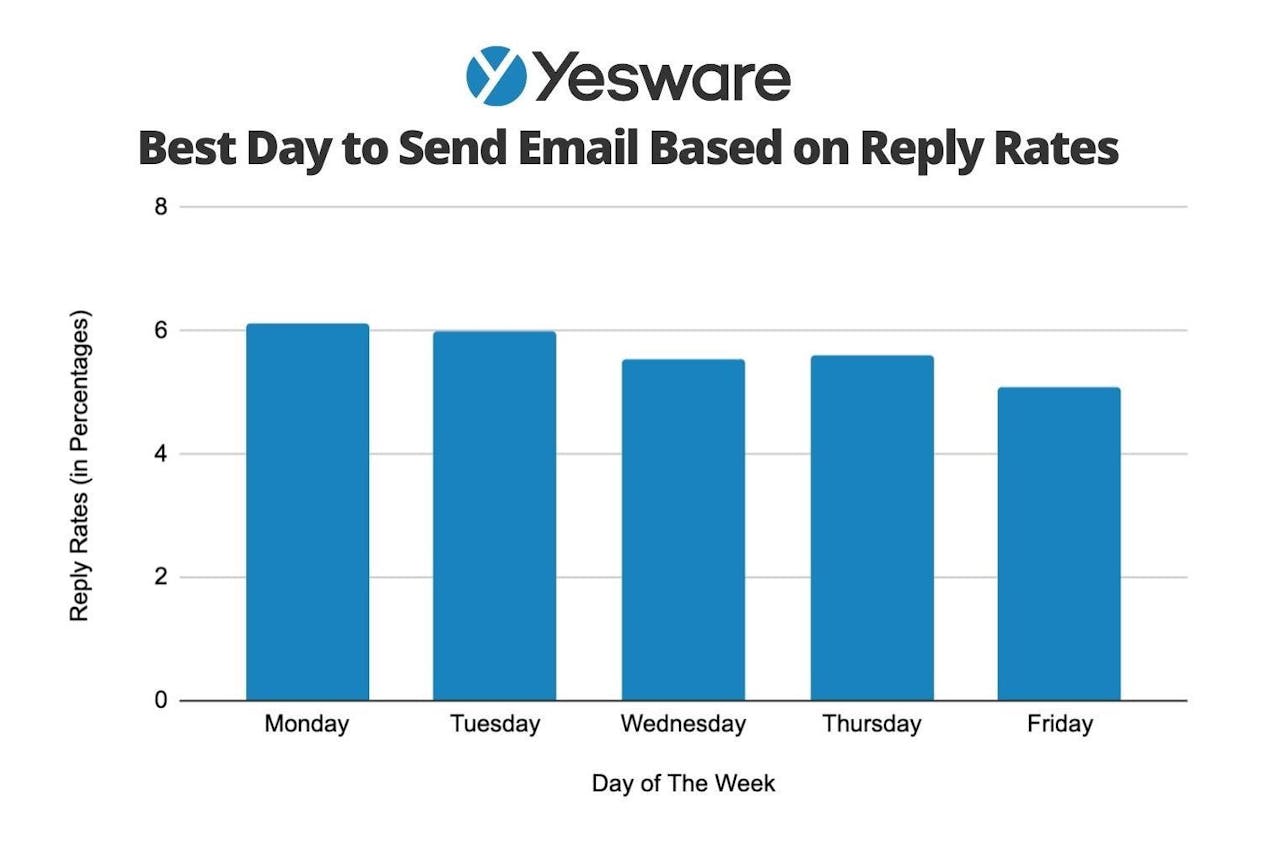
The data also indicates that the most inactive day of the week is Friday, which comes as no surprise.
Various studies advise you to avoid sending cold outreach on Friday as the data shows it is often the worst day to send any campaign or email blast – so here’s another study informing you to do the same. Save yourself the time and effort.
Connecting the dots: try Mondays at 1 PM and 11 AM & Tuesdays at 1 PM and 11 AM. See if you get a spike in replies, then work from there.
It’s all about what resonates with your specific audience. Use this data as a starting point for your own A/B testing. Certain demographics may respond differently to the data we have access to, for example, mid-week campaigns may be more effective for your target audience.
 Sales Engagement Data Trends for Sales Managers to Know Going Into 2022Looking at hundreds of millions of tracked email activity over the past year, this ebook is filled with our top studies & findings to help your sales team accelerate results in 2022.
Sales Engagement Data Trends for Sales Managers to Know Going Into 2022Looking at hundreds of millions of tracked email activity over the past year, this ebook is filled with our top studies & findings to help your sales team accelerate results in 2022.
Email Frequency: Best Time to Send Email Follow-Ups
The Lifespan of an Email
In order to fully dissect the best time to send email, it’s also important to look at the lifespan of an email.
When it comes to email timing, it’s valuable to know when your message will be opened and/or replied to so you can plan your follow-ups accordingly.
Unfortunately, it takes just one day for an email to be a lost cause.
This information will help strategize your B2B sales follow-up behavior and timing.
For this next study, we analyzed over 200,000 data points from sales reps and AE’s email behavior in the past quarter to see how fast a sales email gets opened and replied to so you can create a follow-up cadence around that.
Let’s look at some email benchmarks we found about the life span of an email.
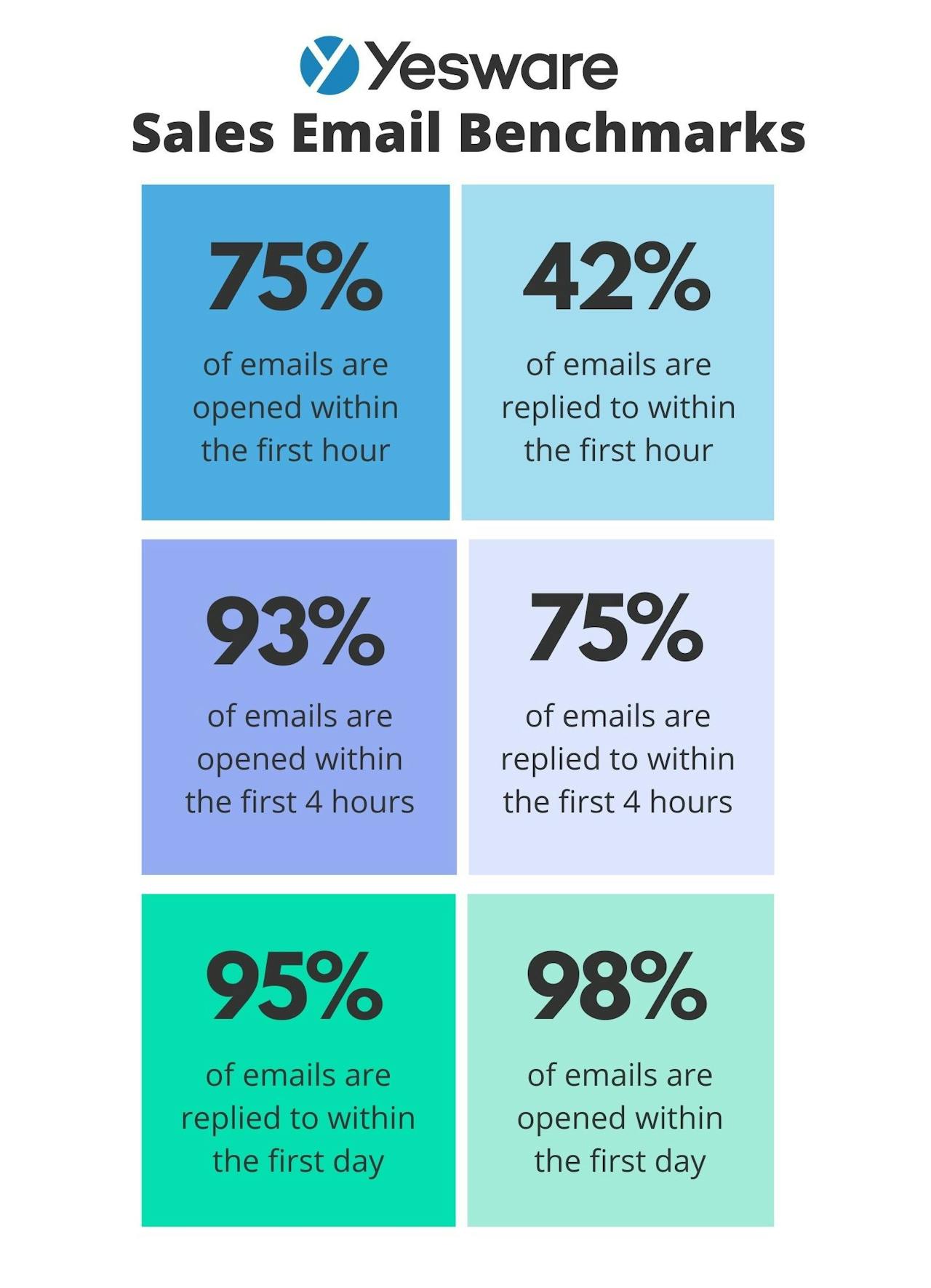 In just the first hour, 75% of emails are opened and 42% of emails are replied to. And in the first 4 hours, 93% of emails are opened and 75% of emails are replied to.
In just the first hour, 75% of emails are opened and 42% of emails are replied to. And in the first 4 hours, 93% of emails are opened and 75% of emails are replied to.
This data is significant for planning your follow-up – by knowing when your email is a lost cause and when you should try again.
The most shocking finding from this study is how incredibly short the life span of an email is.
Most emails are toast after 24 hours – 95% of emails are replied to within the first day and 98% of emails are opened within the first day.
What does this tell you? If you haven’t heard back by then, reach out again. If a prospect really wants to respond to your email, they’ll do it within 24 hours of receiving that email.
There’s no use in waiting around, send that follow-up sooner rather than later.
Email Reply Time in Days
As discovered in our best time to send email data, timing is everything.
As seen below, 95% of emails are replied to within the first day and only 2.8% are replied to a day later. And it only gets worse from there.
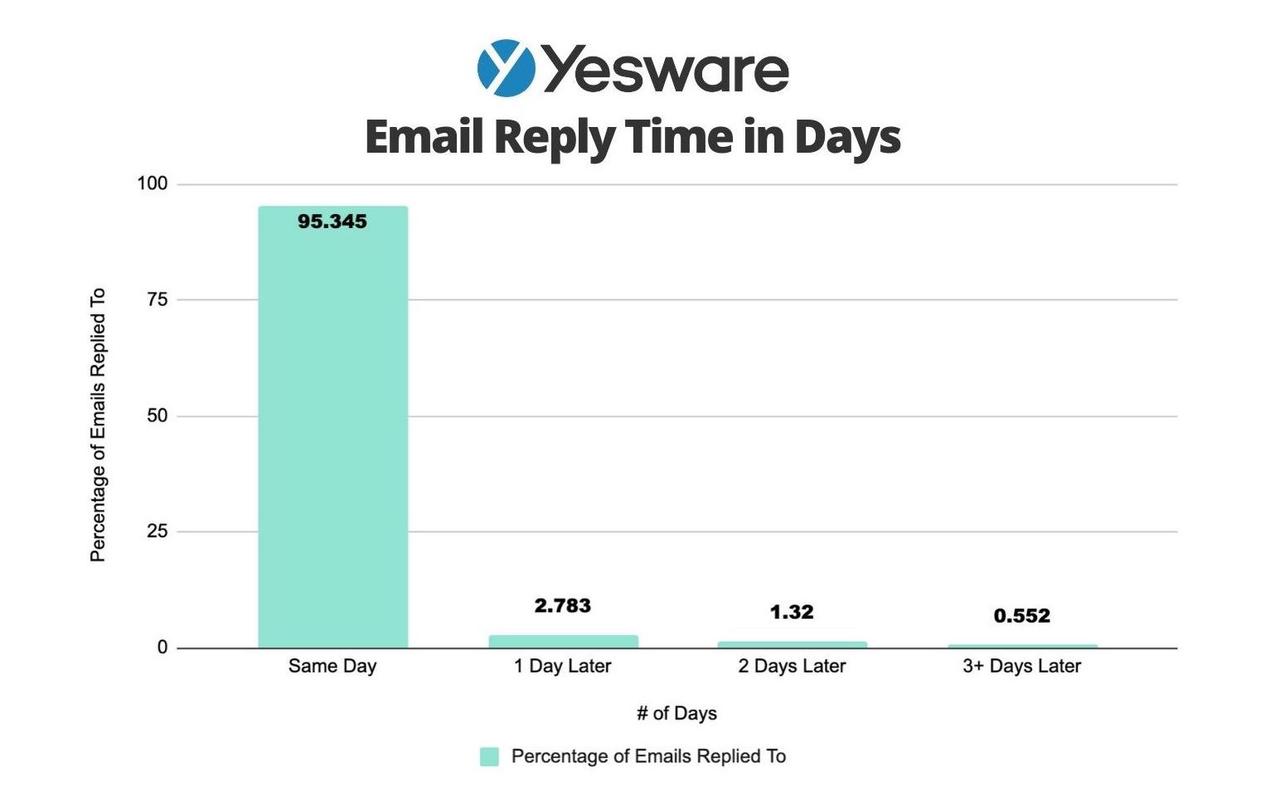
Our data tells us that if your email is ever going to be opened, 95% of the time it’s opened within a day after you send it.
What this means: It pays to be proactive.
After you send a tracked email and can see that it’s opened, the countdown is on.
Any replies will most likely occur that day, so don’t sit around waiting for a reply if you haven’t received a response within a day or two. Send a follow-up email.
Now let’s look at this broken down by hours.
Email Reply Time in Hours
Breaking it down a step further, how do recipients respond to emails hourly after you click send? 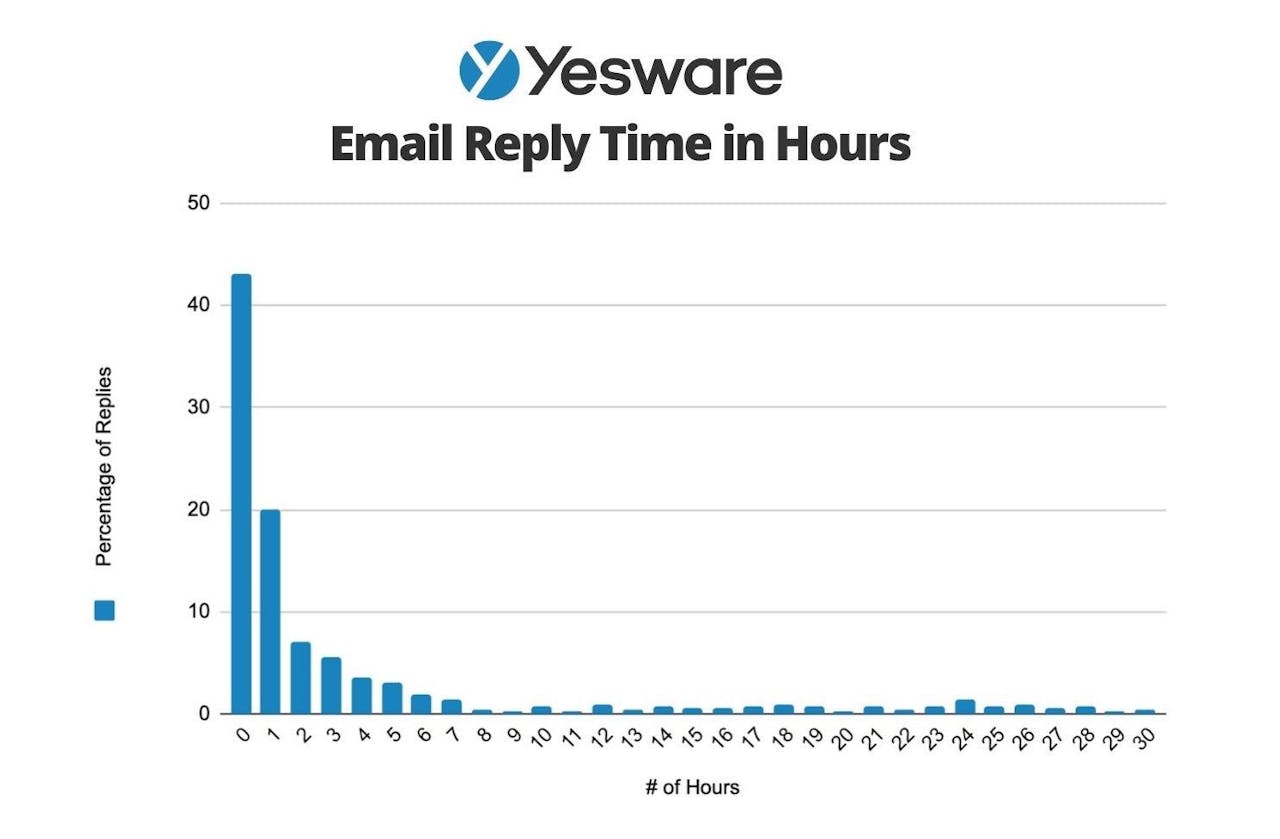
42% of emails are replied to within the first hour and 75% of emails are replied to within the first 4 hours.
The key here is to always track your emails. When you get notified that your first email is opened, this helps you get context on mapping out your next follow-up.
Between 6-10 hours after your email is opened, if you’re not getting a response, that’s a key indicator that you should go for your next touch.
All in all, an email’s lifespan is incredibly short, which makes your follow-up messaging incredibly important.
Overall Best Time to Send Email Campaigns: Connecting the Dots
Based on this data, try sending your email on a Monday at 1 PM, and if the message isn’t replied to within 24 hours, send a follow-up on Tuesday at 11 AM.
See how this cadence works for you and your audience.
Continue to keep track of the recipient’s response time and plan your follow-ups accordingly. Try multiple of the highly-replied to times and days above to see what sticks.
Performing an A/B test of your emails is one of the best things you can do in sales to learn what messaging and specific timing works best for your audience.
This optimal time to send email data is a great starting point but needs to be tested and adjusted accordingly based on your audience. Take this data, use it yourself, measure its outcome, and keep trying new techniques to ensure success.
Bonus: Additional Findings — Different Cities Reply to Emails at Different Times
This isn’t the only study we conducted on best time to send emails.
Back in 2018, Yesware Data Scientist, Richard Ng, analyzed hundreds of millions of emails sent by Yesware users to find how reply rates varied across major metropolitan areas around the world when sent at different times.
The Yesware team analyzed the emails that reach large cities and broke down the reply rates based on when the email was received in their own local time zones. This led to uncovering aggregate trends on how people from different cities around the world respond to emails throughout their workday.
Better yet, the Yesware team created a free tool based on this data to help users reach recipient’s inboxes at the best possible time.
Free Tool: The Best Time to Send Email Map
The Yesware team created a Best Time to Send Email Map. It’s a free online tool that:
- Identifies a send time with the highest computed reply rates in a destination city
- Uses your origin city to suggest the best time to send in your own, local time zone
What’s in it for you? The tool allows you to input where you’re sending your email from (origin city) and where you’re sending your email to (destination city) and suggests the best time to send:
Pro tip: It pairs nicely with our email scheduler so that you can use automation to send all your emails at the right time.
Use our email tracking tool straight from your inbox to learn what times of day work best for your prospects, monitor click rates, and gauge how effective your campaigns are.
Conclusion
Try out the findings from both the 2020 study as well as 2018. Remember, buyer behaviors are constantly changing, so make sure to test and measure.
See what resonates with your audience and whether certain strategies boost your reply rates.
It’s our mission to help you work smarter right from your inbox. We hope that you enjoy our Best Time to Send an Email Map and stay tuned for more email best practices, tips, and tricks on the Yesware blog.
Hungry for More Data? Watch Our Webinar — What Customer Data Reveals About Yesware Best Practices
Get sales tips and strategies delivered straight to your inbox.
Yesware will help you generate more sales right from your inbox. Try our Outlook add-on or Gmail Chrome extension for free, forever!
Related Articles
Jenny Keohane
Jenny Keohane
Jenny Keohane
Sales, deal management, and communication tips for your inbox
![Best Time to Send Email: Time, Day, and Frequency [2020 Data]](/blog/_next/image/?url=https%3A%2F%2Fwww.yesware.com%2Fwp-content%2Fuploads%2F2018%2F11%2Fyesware-best-time-to-send-email.jpg&w=1984&q=75)
